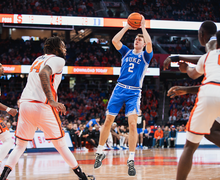Wilson: Syracuse’s late-season collapse remains inexplicable
Yuki Mizuma | Staff Photographer
SU head coach Jim Boeheim (right) cited Syracuse's shooting woes as the team's downfall against Dayton. But as a whole, it's hard to see where SU went wrong as it sputtered down the stretch.
BUFFALO, N.Y. — Michael Gbinije shook his head in silence. Usually one of the most insightful players on the Syracuse roster, he was at a loss for words after Syracuse’s magical season crumbled into an opening-weekend exit from the NCAA Tournament.
It’s almost impossible to think a team that spent nearly a month as the No. 1 team in the country could be eliminated by Dayton on the first Saturday of March Madness, but here he was, having just played his best game of the season, searching for an answer to how.
He remained quiet for a beat. And then another.
“I really don’t know,” he eventually mustered.
From a 25-0 start to a 3-6 finish, there is no easy answer for the Orange’s epic collapse, and that’s reason for concern. The first key to solving a problem is identifying its root, and SU could never do that.
Ask Jim Boeheim, however, and he’ll say it’s obvious.
“When you make shots, you win,” he said after the loss to Dayton, and he’s said some variation of that after each of Syracuse’s six losses. “When you don’t make shots, you lose in close games. Early in the year, we made shots.”
But nothing’s ever that simple.
The Orange’s offense was ugly all season and the margin of error was always slim — and it was kind of like that when SU went to the Final Four last year, too. When things went wrong, though, Syracuse could lean on its elite defense.
On Feb. 15, when Syracuse hosted North Carolina State, the Orange’s offense was even worse than it was on Saturday. SU shot just 35.2 percent from the field — its second-worst rate of the season to that point — but turned defense into offense for a crucial bucket.
“We didn’t get stops that we got in the start,” Syracuse guard Tyler Ennis said, “and I think it caught up to us not focusing on our defense early.”
We’ve got bad shooting and lack of defensive intensity … Any other suggestions?
“It looked like that for a little bit — it looked like we couldn’t lose,” SU guard Trevor Cooney said, “we were just going to always find a way to win.”
So how about complacency? More than three months into the season, the Orange still hadn’t faced any adversity. And when it finally came, it hit Syracuse like a train.
It started with the stunning upset loss to Boston College in the Carrier Dome, and just three days later it traveled down to Durham, N.C., to face Duke. The Orange battled, but then came the “worst call of the year.”
Boeheim tried to light a fire, but it didn’t resonate. The feeling in the locker room after the game was more an air of disappointment than of a team with something to prove.
Syracuse had games against teams it should have put away — two days after the trip to Cameron Indoor Stadium it had an early cushion against Maryland — but the Orange insisted to live on the edge.
“Every game we played really close,” SU center Baye Moussa Keita said on Saturday. “Tonight was a close one, but we just missed that little thing to close it out.
“It’s kind of surprising. We usually are able to close games.”
It’s probably not fair to say a team that started 25-0 with a pair of first-round prospects, an All-American and a Hall of Fame coach was fatally flawed, but that attitude is a bad habit.
A perfect start can cover up plenty of problems, and when they were all revealed it was too late to fix it. Syracuse lost its mojo and never could get it back. And once that happened, the Orange’s once-vivid dreams of Dallas faded into a familiar early exit.
“It’s kind of ironic with all the buzzer beaters and comebacks we’ve had,” Ennis said. “Sooner or later you’re not going to be able to win on buzzer-beaters and last-second plays.”
Published on March 24, 2014 at 1:30 am





